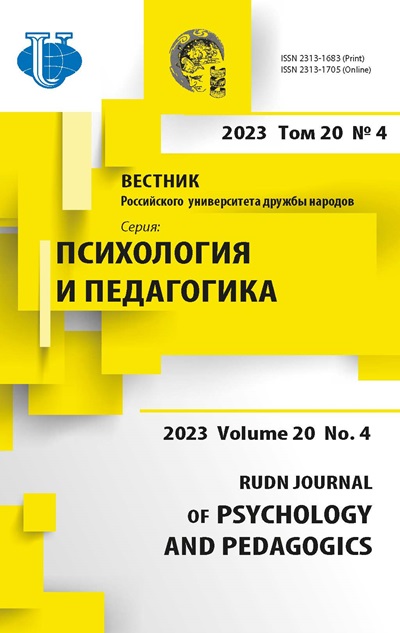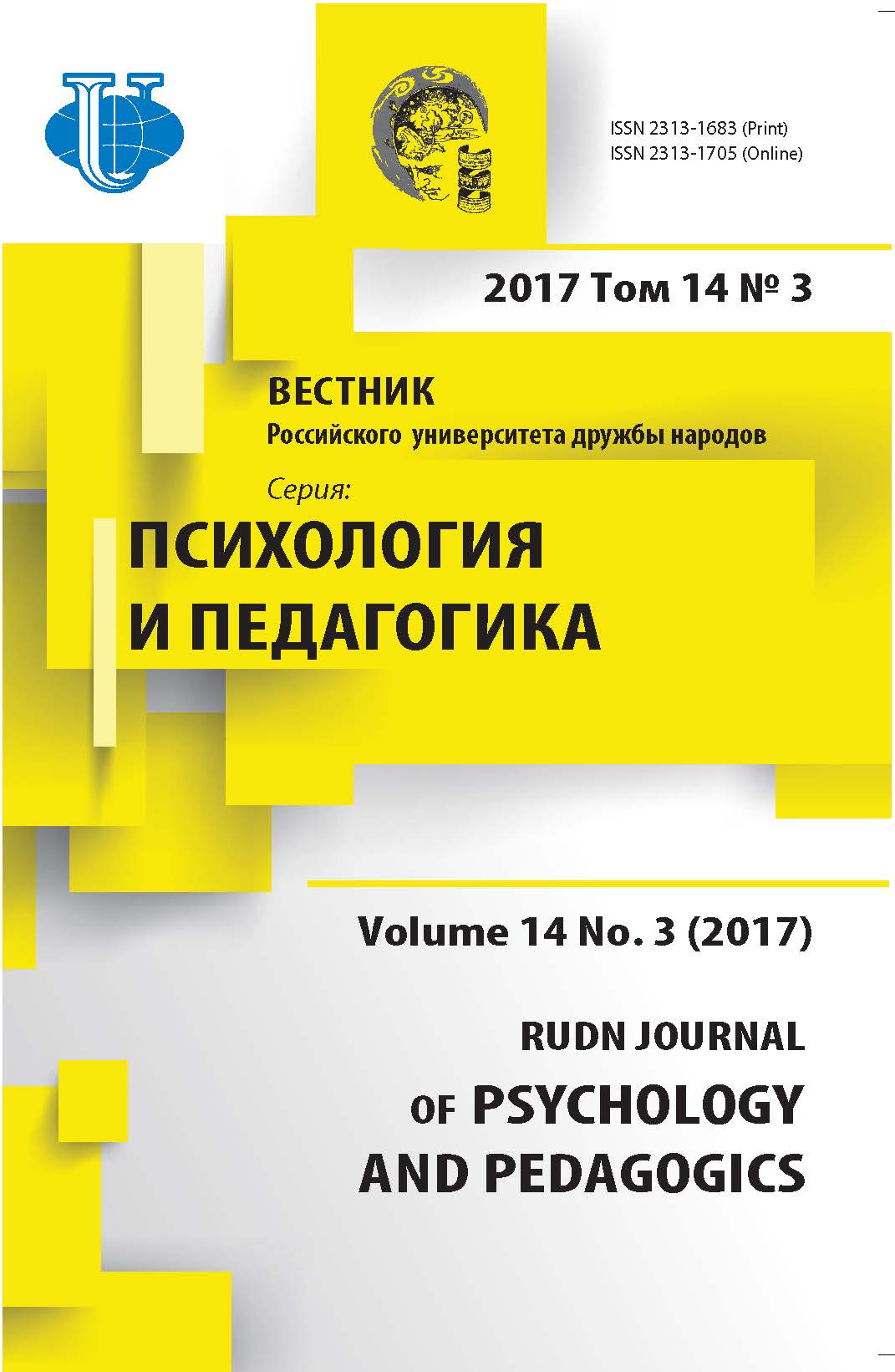ПРОФИЛИ МЕЖКУЛЬТУРНОЙ КОМПЕТЕНТНОСТИ РОССИЙСКИХ СТУДЕНТОВ
- Авторы: Новикова ИА1, Новиков АЛ1, Гридунова МВ1, Замалдинова ГН2
-
Учреждения:
- Российский университет дружбы народов
- Национальный исследовательский технологический университет «МИСиС»
- Выпуск: Том 14, № 3 (2017)
- Страницы: 326-338
- Раздел: Статьи
- URL: https://journals.rudn.ru/psychology-pedagogics/article/view/16592
- DOI: https://doi.org/10.22363/2313-1683-2017-14-3-326-338
Цитировать
Полный текст
Аннотация
Об авторах
И А Новикова
Российский университет дружбы народов
Email: Novikova_ia@rudn.university
кандидат психологических наук, доцент, доцент кафедры социальной и дифференциальной психологии Российского университета дружбы народов (Москва, Россия) ул. Миклухо-Маклая, 6, Москва, Россия, 117198
А Л Новиков
Российский университет дружбы народов
Email: Novikov_al@rudn.university
кандидат филологических наук, доцент, доцент кафедры общего и русского языкознания Российского университета дружбы народов (Москва, Россия) ул. Миклухо-Маклая, 6, Москва, Россия, 117198
М В Гридунова
Российский университет дружбы народов
Email: 1042140174@rudn.university
аспирант кафедры социальной и дифференциальной психологии Российского университета дружбы народов (Москва, Россия) ул. Миклухо-Маклая, 6, Москва, Россия, 117198
Г Н Замалдинова
Национальный исследовательский технологический университет «МИСиС»
Email: rasgut@yandex.ru
кандидат психологических наук, доцент кафедры социальных наук и технологий Национального исследовательского технологического университета «МИСиС» (Москва, Россия) Ленинский пр., 4, Москва, Россия, 119049
Список литературы
- Anderson, P.H., Lawton, L., Rexeisen, R.J., & Hubbard, A.C. (2006). Short-term study abroad and intercultural sensitivity: A pilot study. International Journal of Intercultural Relations, 30, 457-469. doi: 10.1016/j.ijintrel.2005.10.004
- Bennett, M.J. (1986). A developmental approach to training for intercultural sensitivity. International Journal of Intercultural Relations, 10, 179-196.
- Bennett, M.J. (1993). Towards Ethnorelativism: A Developmental Model of Intercultural Sensitivity. In Paige M. (Eds.) Education for the Intercultural Experience (pp. 21-71). Yarmouth, ME: Intercultural Press.
- Bodunov, M.V., & Biryukov, S.D. (1989). Big 5: Five-Factor Inventory. Adapted and reproduced by special permission of the Publisher, Psychological Assessment Resources from the NEO Five Factor Inventory by P. Costa, R. McCrae. Form S. Moscow: RAS.
- Borghetti, C. (2013). Considerations on dynamic assessment of intercultural competence. Diversity, plurilingualism and their impact on language testing and assessment. TEASIG Conference Proceedings (pp. 17-20). Siena.
- Byram M. (1997). Teaching and assessing intercultural communicative competence. Clevedon: Multilingual Matters.
- Chernyak, N.V. (2015). Klassifikatsii modelei mezhkul’turnoi kompetentnosti. Almanac of modern science and education, (2), 119-125. (in Russian).
- Chibisova, M., & Khukhlaev, O. (2008). Measuring teachers’ intercultural competence: Towards a theory-based instrument. Book of Abstracts of the 19th International Congress of the International Association for Cross-Cultural Psychology (pp. 237-238). Bremen.
- Costa, P.T., & McCrae, R.R. (1992). Revised NEO Five Factor Inventory (NEO-PI-R) and the NEO Five-Factor Inventory (NEO-FFI). Professional manual. Odessa, FL: Psychological Assessment Resources.
- Deardorff, D.K. (2006). Identification and assessment of intercultural competence as a student outcome of internationalization. Journal of Studies in Intercultural Education, 10, 241-266. doi: 10.1177/1028315306287002.
- Gridunova, M.V., Novikova, I.A., & Shlyakhta, D.A. (2017). Intercultural competence and the factors of the “Big five”: the formulation of the problem. Izv. Saratov Univ. (N. S.), Ser. Educational Aсmeology. Developmental Psychology, 6 (2), 140-148. (in Russian). doi: 10.18500/2304-9790-2017-6-2-140-147. (In Russ.).
- Gridunova, M.V., Novikova, I.A., Radoev, M., & Shlyakhta, D.A. (2017). The relation between intercultural competence, personality features and students’ intellectual development). Journal of the Institute for Educational Research, 49(1), 77-98. doi: 10.2298/ZIPI1701077G. (in Serbian).
- Hammer, M.R., Bennett, M.J., & Wiseman, R. (2003). Measuring intercultural sensitivity: The Intercultural Development Inventory. International Journal of Intercultural Relations, 27, 421-443. doi: 10.1016/S0147-1767(03)00032-4
- Huang, T., Chi, S., & Lawler, J.J. (2005). The relationship between expatriates’ personality traits and their adjustment to international assignments. International Journal of Human Resource Management, 16(9), 1656-1670. doi: 10.1080/09585190500239325.
- Kehl, K. & Morris, J. (2007-2008). Differences in global-mindedness between short-term and semester-long study abroad participants at selected private universities. Frontiers: The Interdisciplinary Journal of Study Abroad, 15, 67-79. Retrieved from http://www.frontiersjournal.com/frontiersjournal.comissuesvol15index.htm (accessed 17 January 2017).
- Khukhlaev, O.E., Chibisova, M.Y. (2010). Theoretical and practical issues of intercultural communication: current trends. Psychological science and education, 5, 168-179.
- Kornilova, M.V. (2012). The dynamics of intercultural competence in mono- and multicultural groups (based on the intercultural training) (Ph.D. thesis). Moscow: Moscow City Psychological-Pedagogical University (in Russ.).
- Krupnov, A.I., Novikova, I.A., Vorobyeva, A.A. (2016). On the problem of relation between the System-Functional and The Five-Factor models of personality traits. Bulletin of Peoples’ Friendship University of Russia. Series: Psychology and Pedagogics, (2), 45-56. (In Russ.).
- Logashenko, Y.A. (2014). Sensitivity to cultural differences among students with different experiences of intercultural interaction. The Bulletin of Immanuel Kant Baltic Federal University, (11), 73-81. (In Russ.).
- Logashhenko, Y.A. (2015). Mezhkul’turnaja sensitivnost’ studentov v polijetnicheskoj srede: Ph.D. thesis. St. Petersburg: Saint Petersburg State University. (in Russ.).
- Murzakanova, A.Z. (2015). Specifics of Relation between Tolerance and Personality Traits in Russian and Circassian Students. Bulletin of Peoples’ Friendship University. Series: Psychology and Pedagogics, (4), 57-64 (in Russ.).
- Novikova, I.A., Novikov, A.L., Obidina, N.V. & Shlyakhta, D.A. (2016). Psychological Predictors of Managerial Performance in the Conditions of Instability of the Russian Economy. International Journal of Environmental and Science Education, 11(18), 10863-10874.
- Pochebut, L. G. (2012). Theory of intercultural communicative competence. Nukov Pratsi. Sociology, 184 (172), 14-18. (in Russ.).
- Pochebut, L., Logashenko Y. (2014). An intercultural sensitivity as a professional trait of specialists of humanitarian sphere. Society, Integration, Education: Proceeding of the International Scientific Conference (vol. 1, pp. 207-216). Rezekne: Rezekne Higher Education Institution.
- R Core Team (2016). R: A Language and Environment for Statistical Computing. Vienna: R Foundation for Statistical Computing.
- Revelle, W. & Zinbarg, R.E. (2009). Coefficients alpha, beta, omega and the glb: comments on Sijtsma. Psychometrika, 74 (1), 145-154.
- Rexeisen, R. J. & Al-Khatib, J. (2009). Assurance of learning and study abroad: A case study. Journal of Teaching in International Business, 20, 192-207. doi: 10.1080/08975930903099077
- Sinicrope, C., Norris, J., & Watanabe Y. (2007). Understanding and assessing intercultural competence: a summary of theory, research and practice. Second Language Studies, 26 (1), 1-58.
- Skopinskaja L. (2009). Assessing intercultural communicative competence: test construction issues. Synergies Pays Riverains de la Baltique, 6, 135-144.
- UNESCO. (2013). Intercultural competences: Conceptual and Operational Framework. Paris: UNESCO. Available from: unesdoc.unesco.org/images/0021/002197/219768e.pdf. (accessed 20 December 2016).
- Van der Zee, K.I., & Van der Gang, I. (2007). Personality, threat and effective responses to cultural diversity. European Journal of Personality, 21, 453-470.
- Van der Zee, K.I., & Van Oudenhoven, J.P. (2013). Culture shock or challenge? The role of personality as a determinant of intercultural competence. Journal of Cross-Cultural Psychology, 44, 928-940. doi: 10.1177/0022022113493138
- Van der Zee, K.I., & Van Oudenhoven, J.P. (2014). Personality and multicultural effectiveness. In Benet-Martínez V., Hong Ying-Yi (Eds.) The Oxford handbook of multicultural identity (pp. 255-275). New York, NY, US: Oxford University Press.
- Yeke S., Semerciöz F. (2016). Relationship between personality traits, cultural intelligence and intercultural communication competence. Procedia - Social and Behavioral Sciences, 235, 313-319. doi: 10.1016/j.sbspro.2016.11.036.
















